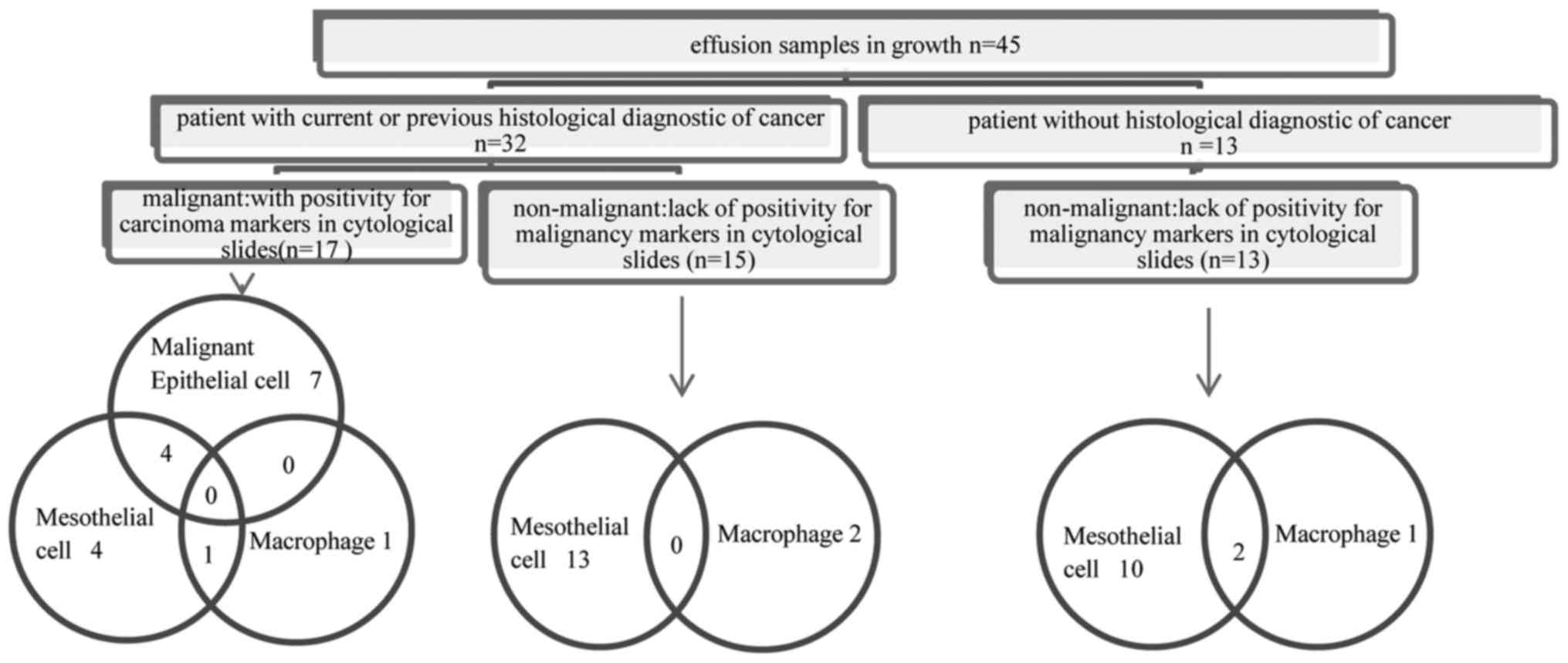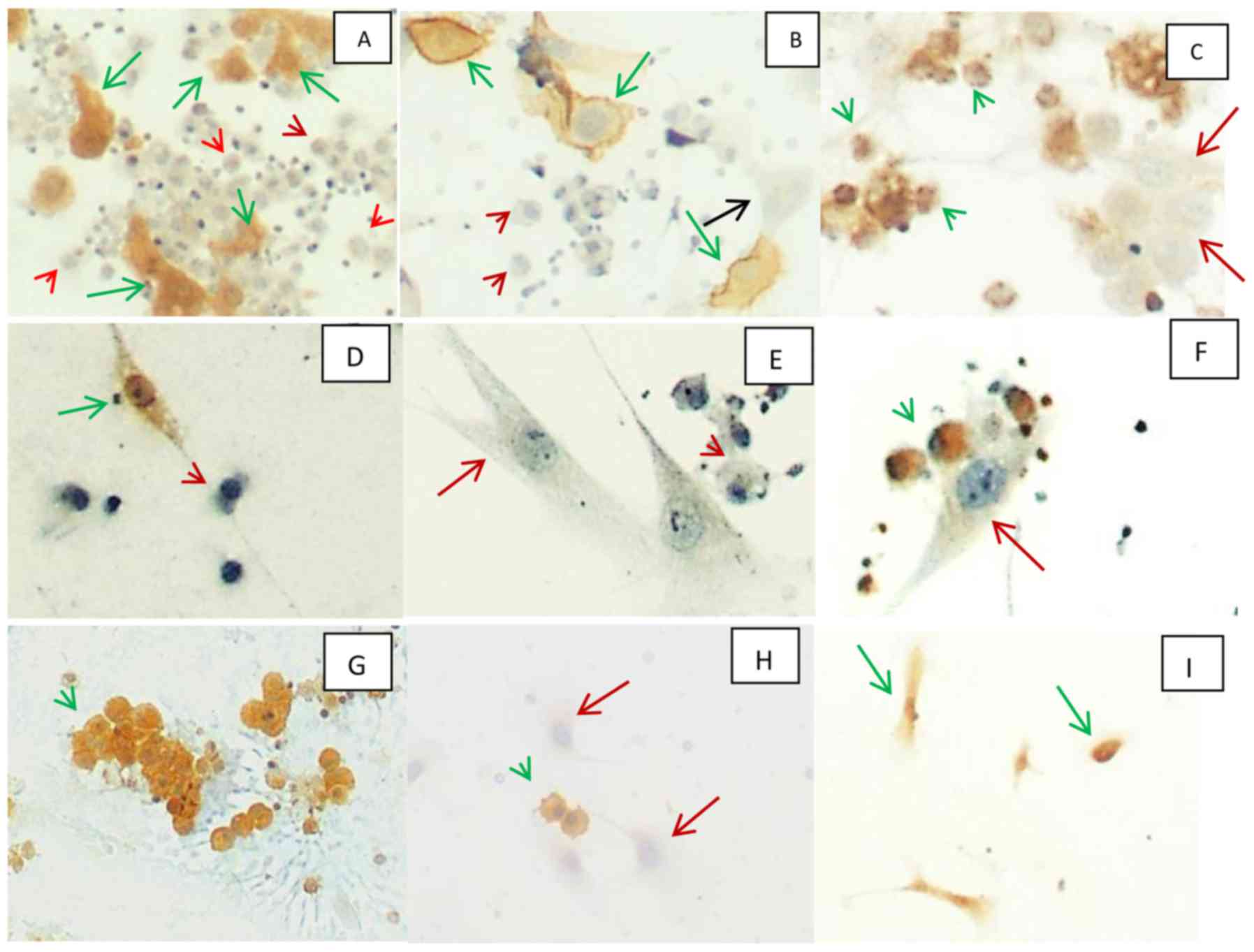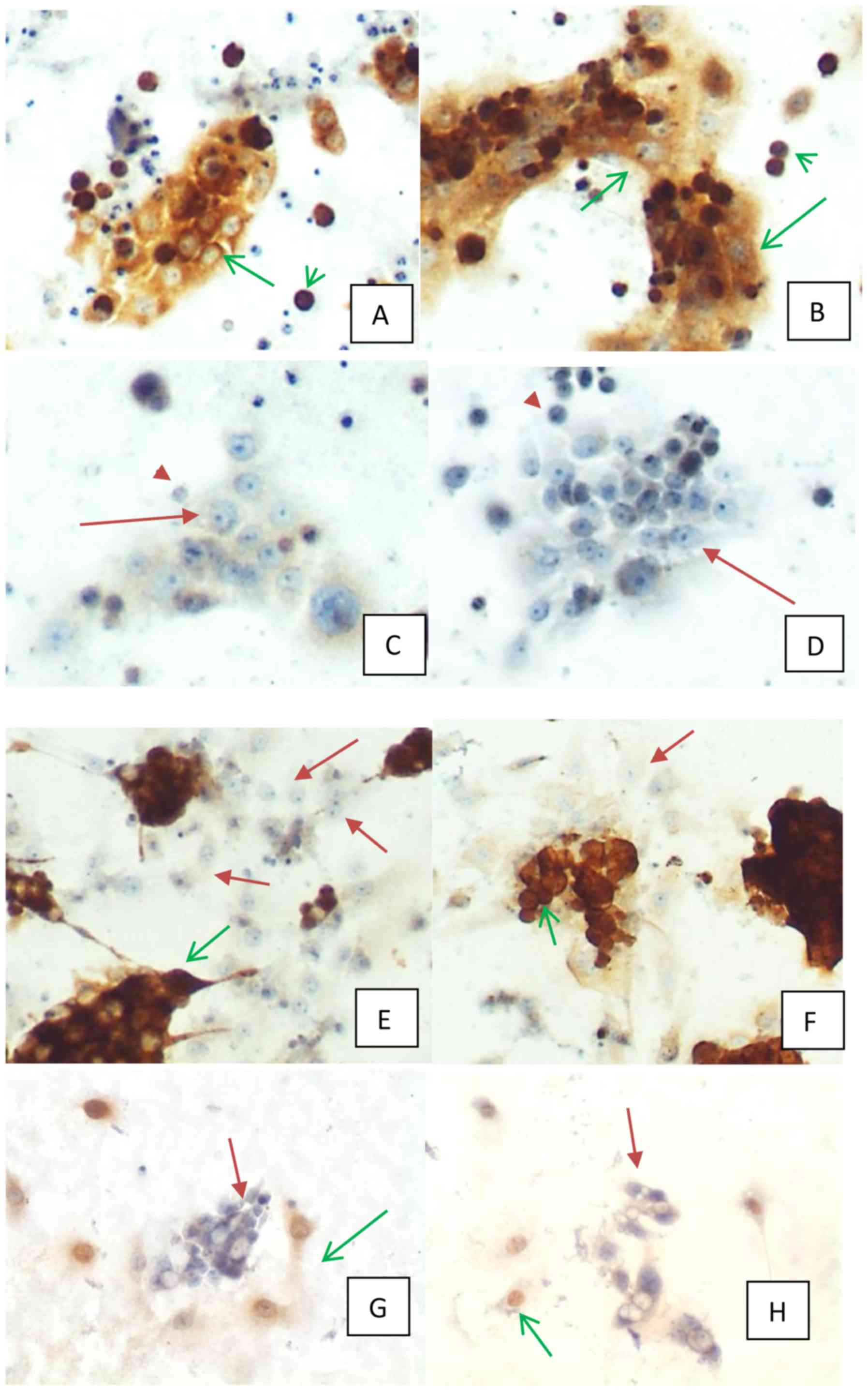|
1
|
Ruiz C, Kustermann S, Pietilae E, Vlajnic
T, Baschiera B, Arabi L, Lorber T, Oeggerli M, Savic S, Obermann E,
et al: Culture and drug profiling of patient derived malignant
pleural effusions for personalized cancer medicine. PLoS One.
11:e01608072016. View Article : Google Scholar : PubMed/NCBI
|
|
2
|
Roscilli G, De Vitis C, Ferrara FF, Noto
A, Cherubini E, Ricci A, Mariotta S, Giarnieri E, Giovagnoli MR,
Torrisi MR, et al: Human lung adenocarcinoma cell cultures derived
from malignant pleural effusions as model system to predict
patients chemosensitivity. J Transl Med. 14:612016. View Article : Google Scholar : PubMed/NCBI
|
|
3
|
Bezdieniezhnykh N, Lykhova A, Semesiuk N,
Okhrimenko R and Kudryavets Y: Establishment and characterization
of new breast and ovarian cancer cell lines as a model for studying
cellular plasticity in vitro. Exp Oncol. 38:94–100. 2016.PubMed/NCBI
|
|
4
|
Ku JL, Park SC, Kim KH, Jeon YK, Kim SH,
Shin YK, Noh DY, Im SA, Bang YJ, Han W, et al: Establishment and
characterization of seven human breast cancer cell lines including
two triple-negative cell lines. Int J Oncol. 43:2073–2081. 2013.
View Article : Google Scholar : PubMed/NCBI
|
|
5
|
Basak SK, Veena MS, Oh S, Huang G,
Srivatsan E, Huang M, Sharma S and Batra RK: The malignant pleural
effusion as a model to investigate intratumoral heterogeneity in
lung cancer. PLoS One. 4:e58842009. View Article : Google Scholar : PubMed/NCBI
|
|
6
|
Ricci A, De Vitis C, Noto A, Fattore L,
Mariotta S, Cherubini E, Roscilli G, Liguori G, Scognamiglio G,
Rocco G, et al: TrkB is responsible for EMT transition in malignant
pleural effusions derived cultures from adenocarcinoma of the lung.
Cell Cycle. 12:1696–1703. 2013. View
Article : Google Scholar : PubMed/NCBI
|
|
7
|
Chen SF, Lin YS, Jao SW, Chang YC, Liu CL,
Lin YJ and Nieh S: Pulmonary adenocarcinoma in malignant pleural
effusion enriches cancer stem cell properties during metastatic
cascade. PLoS One. 8:e546592013. View Article : Google Scholar : PubMed/NCBI
|
|
8
|
Yin T, Wang G, He S, Shen G, Su C, Zhang
Y, Wei X, Ye T, Li L, Yang S, et al: Malignant pleural effusion and
ascites induce epithelial-mesenchymal transition and cancer
stem-like cell properties via the vascular endothelial growth
factor (VEGF)/phosphatidylinositol 3-kinase (PI3K)/Akt/mechanistic
target of eapamycin (mTOR) pathway. J Biol Chem. 291:26750–26761.
2016. View Article : Google Scholar : PubMed/NCBI
|
|
9
|
Francis IM, Alath P, George SS, Jaragh M,
Al Jassar A and Kapila K: Metastatic breast carcinoma in pleural
fluid: Correlation of receptor and HER2 status with the primary
carcinoma - a pilot study. Diagn Cytopathol. 44:980–986. 2016.
View Article : Google Scholar : PubMed/NCBI
|
|
10
|
Kalogeraki A, Lazopoulos G, Papadakis GZ,
Tamiolakis D, Karvela-Kalogeraki I, Karvelas-Kalogerakis M,
Segredakis J, Papadakis M, Moustou E, Datseri G, et al: Cytology of
pericardial effusion due to malignancy. Rom J Intern Med.
54:179–183. 2016.PubMed/NCBI
|
|
11
|
Kalogeraki A, Tamiolakis D, Datseri G,
Lazopoulos G, Karvelas-Kalogerakis M, Segredakis J and Zoi I:
Pleural effusion cytology due to malignancy. A combined
cytomorphological-immunocytochemical study of 500 cases. Rev Port
Pneumol 2006. 22:290–291. 2016.PubMed/NCBI
|
|
12
|
Antonangelo L, Sales RK, Corá AP, Acencio
MM, Teixeira LR and Vargas FS: Pleural fluid tumour markers in
malignant pleural effusion with inconclusive cytologic results.
Curr Oncol. 22:e336–e341. 2015. View Article : Google Scholar : PubMed/NCBI
|
|
13
|
Westfall DE, Fan X and Marchevsky AM:
Evidence-based guidelines to optimize the selection of antibody
panels in cytopathology: Pleural effusions with malignant
epithelioid cells. Diagn Cytopathol. 38:9–14. 2010.PubMed/NCBI
|
|
14
|
Su XY, Li GD, Liu WP, Xie B and Jiang YH:
Cytological differential diagnosis among adenocarcinoma, epithelial
mesothelioma, and reactive mesothelial cells in serous effusions by
immunocytochemistry. Diagn Cytopathol. 39:900–908. 2011. View Article : Google Scholar : PubMed/NCBI
|
|
15
|
Lyons-Boudreaux V, Mody DR, Zhai J and
Coffey D: Cytologic malignancy versus benignancy: How useful are
the ‘newer’ markers in body fluid cytology? Arch Pathol Lab Med.
132:23–28. 2008.PubMed/NCBI
|
|
16
|
Saleh HA, El-Fakharany M, Makki H, Kadhim
A and Masood S: Differentiating reactive mesothelial cells from
metastatic adenocarcinoma in serous effusions: The utility of
immunocytochemical panel in the differential diagnosis. Diagn
Cytopathol. 37:324–332. 2009. View
Article : Google Scholar : PubMed/NCBI
|
|
17
|
Kim JH, Kim GE, Choi YD, Lee JS, Lee JH,
Nam JH and Choi C: Immunocytochemical panel for distinguishing
between adenocarcinomas and reactive mesothelial cells in effusion
cell blocks. Diagn Cytopathol. 37:258–261. 2009. View Article : Google Scholar : PubMed/NCBI
|
|
18
|
Qureshi-Baig K, Ullmann P, Rodriguez F,
Frasquilho S, Nazarov PV, Haan S and Letellier E: What do we learn
from spheroid culture systems? Insights from tumorspheres derived
from primary colon cancer tissue. PLoS One. 11:e01460522016.
View Article : Google Scholar : PubMed/NCBI
|
|
19
|
Yung S and Chan TM: Mesothelial cells.
Perit Dial Int. 27 Suppl 2:S110–S115. 2007.PubMed/NCBI
|
|
20
|
Yung S, Li FK and Chan TM: Peritoneal
mesothelial cell culture and biology. Perit Dial Int. 26:162–173.
2006.PubMed/NCBI
|
|
21
|
Mutsaers SE, Whitaker D and Papadimitriou
JM: Stimulation of mesothelial cell proliferation by exudate
macrophages enhances serosal wound healing in a murine model. Am J
Pathol. 160:681–692. 2002. View Article : Google Scholar : PubMed/NCBI
|
|
22
|
Zhou Q and Yu X: Isolation and propagation
of rat peritoneal mesothelial cells. Methods Mol Biol. 1397:25–34.
2016. View Article : Google Scholar : PubMed/NCBI
|
|
23
|
Ranieri D, Raffa S, Parente A, Del Monte
Rossi S, Ziparo V and Torrisi MR: High adhesion of tumor cells to
mesothelial monolayers derived from peritoneal wash of disseminated
gastrointestinal cancers. PLoS One. 8:e576592013. View Article : Google Scholar : PubMed/NCBI
|
|
24
|
Tsukada T, Fushida S, Harada S, Yagi Y,
Kinoshita J, Oyama K, Tajima H, Fujita H, Ninomiya I, Fujimura T,
et al: The role of human peritoneal mesothelial cells in the
fibrosis and progression of gastric cancer. Int J Oncol.
41:476–482. 2012. View Article : Google Scholar : PubMed/NCBI
|
|
25
|
Cabourne EJ, Roberts G, Goldin R, Ryder T,
Mobberly M and Ziprin P: Investigation of tumor-peritoneal
interactions in the pathogenesis of peritoneal metastases using a
novel ex vivo peritoneal model. J Surg Res. 164:e265–e272. 2010.
View Article : Google Scholar : PubMed/NCBI
|
|
26
|
Lv M, Leng JH, Hao YY, Sun Y, Cha N and Wu
GP: Expression and significance of MOC-31 and calretinin in pleural
fluid of patients with lung cancer. Diagn Cytopathol. 43:527–531.
2015. View
Article : Google Scholar : PubMed/NCBI
|
|
27
|
Hyun TS, Barnes M and Tabatabai ZL: The
diagnostic utility of D2-40, calretinin, CK5/6, desmin and MOC-31
in the differentiation of mesothelioma from adenocarcinoma in
pleural effusion cytology. Acta Cytol. 56:527–532. 2012. View Article : Google Scholar : PubMed/NCBI
|
|
28
|
Fetsch PA, Simsir A and Abati A:
Comparison of antibodies to HBME-1 and calretinin for the detection
of mesothelial cells in effusion cytology. Diagn Cytopathol.
25:158–161. 2001. View
Article : Google Scholar : PubMed/NCBI
|
|
29
|
Zhao L, Guo M, Sneige N and Gong Y: Value
of PAX8 and WT1 immunostaining in confirming the ovarian origin of
metastatic carcinoma in serous effusion specimens. Am J Clin
Pathol. 137:304–309. 2012. View Article : Google Scholar : PubMed/NCBI
|
|
30
|
Oda T, Ogata S, Kawaguchi S, Minabe S,
Dokyu M, Takahashi H, Kumazawa F, Shimazaki H, Takano M, Hase K, et
al: Immunocytochemical utility of claudin-4 versus those of Ber-EP4
and MOC-31 in effusion cytology. Diagn Cytopathol. 44:499–504.
2016. View
Article : Google Scholar : PubMed/NCBI
|
|
31
|
Kundu UR and Krishnamurthy S: Use of the
monoclonal antibody MOC-31 as an immunomarker for detecting
metastatic adenocarcinoma in effusion cytology. Cancer Cytopathol.
119:272–278. 2011. View Article : Google Scholar : PubMed/NCBI
|
|
32
|
Kim NI, Kim GE and Lee JS: Diagnostic
usefulness of claudin-3 and claudin-4 for immunocytochemical
differentiation between metastatic adenocarcinoma cells and
reactive mesothelial cells in effusion cell blocks. Acta Cytol.
60:232–239. 2016. View Article : Google Scholar : PubMed/NCBI
|
|
33
|
Ikeda K, Tate G, Suzuki T, Kitamura T and
Mitsuya T: IMP3/L523S, a novel immunocytochemical marker that
distinguishes benign and malignant cells: The expression profiles
of IMP3/L523S in effusion cytology. Hum Pathol. 41:745–750. 2010.
View Article : Google Scholar : PubMed/NCBI
|
|
34
|
Hanley KZ, Facik MS, Bourne PA, Yang Q,
Spaulding BO, Bonfiglio TA and Xu H: Utility of anti-L523S antibody
in the diagnosis of benign and malignant serous effusions. Cancer.
114:49–56. 2008. View Article : Google Scholar : PubMed/NCBI
|
|
35
|
Jing X, Li QK, Bedrossian U and Michael
CW: Morphologic and immunocytochemical performances of effusion
cell blocks prepared using 3 different methods. Am J Clin Pathol.
139:177–182. 2013. View Article : Google Scholar : PubMed/NCBI
|
|
36
|
Ebata T, Okuma Y, Nakahara Y, Yomota M,
Takagi Y, Hosomi Y, Asami E, Omuro Y, Hishima T, Okamura T, et al:
Retrospective analysis of unknown primary cancers with malignant
pleural effusion at initial diagnosis. Thorac Cancer. 7:39–43.
2016. View Article : Google Scholar : PubMed/NCBI
|
|
37
|
Lew M, Pang JC, Jing X, Fields KL and Roh
MH: Young investigator challenge: The utility of GATA3
immunohistochemistry in the evaluation of metastatic breast
carcinomas in malignant effusions. Cancer Cytopathol. 123:576–581.
2015. View Article : Google Scholar : PubMed/NCBI
|
|
38
|
Porcel JM, Palma R, Bielsa S, Esquerda A,
Gatius S, Matias-Guiu X and Salud A: TTF-1 and napsin A on cell
blocks and supernatants of pleural fluids for labeling malignant
effusions. Respirology. 20:831–833. 2015. View Article : Google Scholar : PubMed/NCBI
|
|
39
|
Moh M, Krings G, Ates D, Aysal A, Kim GE
and Rabban JT: SATB2 expression distinguishes ovarian metastases of
colorectal and appendiceal origin from primary ovarian Tumors of
mucinous or endometrioid type. Am J Surg Pathol. 40:419–432. 2016.
View Article : Google Scholar : PubMed/NCBI
|
|
40
|
Seipel AH, Samaratunga H, Delahunt B,
Wiklund P, Clements M and Egevad L: Immunohistochemistry of ductal
adenocarcinoma of the prostate and adenocarcinomas of non-prostatic
origin: A comparative study. APMIS. 124:263–270. 2016. View Article : Google Scholar : PubMed/NCBI
|
|
41
|
McKnight R, Cohen C and Siddiqui MT:
Utility of paired box gene 8 (PAX8) expression in fluid and
fine-needle aspiration cytology: an immunohistochemical study of
metastatic ovarian serous carcinoma. Cancer Cytopathol. 25:298–302.
2010. View Article : Google Scholar
|
|
42
|
Waters L, Crumley S, Truong L, Mody D and
Coffey D: PAX2 and PAX8: Useful markers for metastatic effusions.
Acta Cytol. 58:60–66. 2014. View Article : Google Scholar : PubMed/NCBI
|
|
43
|
Barr ML, Jilaveanu LB, Camp RL, Adeniran
AJ, Kluger HM and Shuch B: PAX-8 expression in renal tumours and
distant sites: A useful marker of primary and metastatic renal cell
carcinoma? J Clin Pathol. 68:12–17. 2015. View Article : Google Scholar : PubMed/NCBI
|
|
44
|
Chute DJ, Kong CS and Stelow EB:
Immunohistochemistry for the detection of renal cell carcinoma in
effusion cytology. Diagn Cytopathol. 39:118–123. 2011. View Article : Google Scholar : PubMed/NCBI
|
|
45
|
Karabork A, Kaygusuz G and Ekinci C: The
best immunohisto-chemical panel for differentiating hepatocellular
carcinoma from metastatic adenocarcinoma. Pathol Res Pract.
206:572–577. 2010. View Article : Google Scholar : PubMed/NCBI
|
|
46
|
Pu RT, Pang Y and Michael CW: Utility of
WT-1, p63, MOC31, mesothelin, and cytokeratin (K903 and CK5/6)
immunostains in differentiating adenocarcinoma, squamous cell
carcinoma, and malignant mesothelioma in effusions. Diagn
Cytopathol. 36:20–25. 2008. View
Article : Google Scholar : PubMed/NCBI
|












